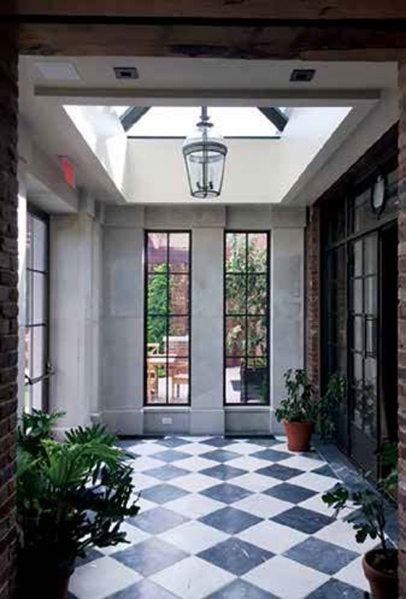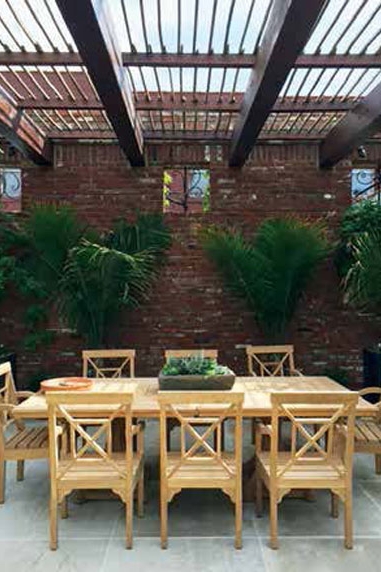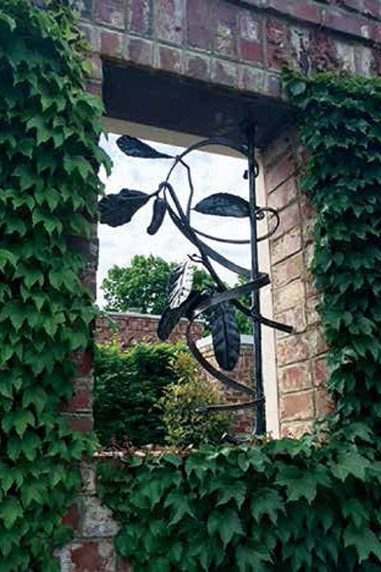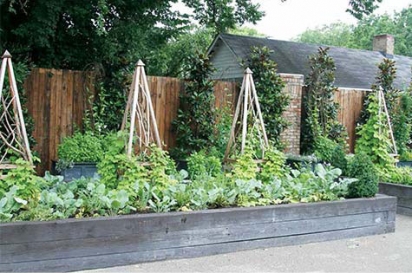An Appetizing Apiary
Thoughtful design, gardens cater to ‘magic in the kitchen’
When the Vaughan family asked us to help with the outdoor design of the Apiary, which they co-own with their son, Cooper, and his wife, Mandy, we jumped at the chance. Starting out as the HQ for their wildly successful catering company, the plan was to create an event space around it like no other.
Knowing the high style of the parents, Neal and Derek, we knew this would be a project that wouldn’t fizzle out in the end like many do when it comes to the garden. Sure, everyone has dreams and plans in the beginning but many times after the long, drawn-out renovation/building of the living space, we get the “we need to hold off for awhile on the landscape” or “can you do a pared-down version of the garden?” For the Vaughans, who are involved in every decision from plants outside and inside to every last piece of fabric on the furniture, we felt confident that the garden surrounding the building would be not be left in the dust. And we were right.
The heart of the property is the kitchen, as it is in every home that creates the fantastic food for the catering company. When we attend functions where the Apiary provides the food, we often say that Cooper creates familiar food but always puts a twist on it that makes you remember it and wonder what magic is going on back in the kitchen.
Using fresh herbs and local produce is all part of the alchemy. All day long, chefs and sous-chefs prepare for upcoming events that are happening off property at local horse farms and other locations.
But if the kitchen is the heart, the rest of the property is the soul. Just open the adjoining door and enter a Tasting Room with an antiqued mirrored bar where brides-to-be, enveloped in luxury, can taste-test a canapé or main course. Open another door and you are in the Winter Room — complete with fireplace, sofas and reclaimed paneling and flooring — which offers a view of the outside vegetable and herb gardens, as well as the Living Wall and fountain.
Adjoining the Winter Room is the Orangerie, which will take your breath away with its imposing 22-foot ceilings and lush Parlor Palms. Here tables can be prepared for as many as 100 guests. Large windows allow you to see out onto the vegetable garden beyond the limestone terrace.
We love that the vegetable and herb gardens weren’t relegated to the back, as in most properties, but were positioned right up front like a jewel. The idea was for the vegetable garden to be openly viewed from the street as people drove or walked by on their way to any one of the fabulous restaurants that have sprung up over the last few years on a street that used to be a bit dangerous. (Our fraternity hazing in the 1980s involved leaving a pledge on Jefferson Street, which tells you how scary the street used to be!)
Much of the success for this resurgence has been the local food craze that has revitalized many a city street all over the United States the past few years. Isn’t it incredible? Consumers are now interested in where their food comes from and we believe this is not a fad but a reality we hope will continue as more health problems are linked to chemicals dumped on food sources from unknown places.
As neighbors, we feel lucky because each of these eateries has a real personality with its food and vibe. The Apiary, situated in the middle of the street, feels like the keystone to all of these places either way, attracting more affluent visitors who will soon make the pilgrimage back on their own to eat at the other locations. It’s a win-win situation for sure.
What made this interesting for us is that not only would the vegetable and herb garden be a source of food for the chefs inside but it would be done with style. Who says you can’t have style with practicality? We’ve made a career out of blending the mundane with the fantastic. And this garden, we knew, would be that and more.
First, we worked off the building plan, designing the garden space from inside the event space in order to create vistas and views that are important in every month, not only when the garden is in full glory.
This had been a burned-out warehouse and underneath was clay and rock, so we used recycled wood beams from the Vaughans’ many tobacco warehouses to build up raised beds. We thought it smart to make them seat height so that during a party people could sit down and “smell the herbs and taste the edible delights.” A rubber liner keeps the wood from deteriorating and a lightweight soil specially formulated by our friends at Landscaper’s Corner close by made it easy to fill.
Despite the worst winter in recent history, the location downtown gave the space protection from the cold wind and we ambitiously planted it earlier than any less optimistic person would have done. The lettuces, cabbages, kales and other cole crops were covered with black plastic several times when the temperatures got down to 10° but miraculously everything came out of it with just minor burns.
As the spring came into full swing, we planted all the herbs and vegetables that a chef could desire and more: basils of all kinds, rosemary, thymes, verbena, dill, fennel and many more unusual varieties that our Chinese garden guru in Bucks County, Pennsylvania, gives us to plant every year. She also provides us with Asian spinach and other leafy vegetables that aren’t found easily.
We purchased other vegetables from the local farmers’ market as well as Wilson’s Nursery in Frankfort, which does an unbelievable job with their edibles; people travel from all over for their selections. Rainwater is collected from the roof into a large underground basin that is used as much as possible. Seed Leaf, a nonprofit whose mission statement says it “exists to nourish communities by growing, cooking, sharing and recycling food,” shares an office space downstairs and will continue to maintain the garden space.
Of course, it takes a team to make anything great and “the devil is in the details,” as they say. Matt and Karine Maynard were blacksmiths extraordinaire, creating fencing and windows inspired by nature. You must see this to believe. It’s exciting to know that such artists are here in Kentucky because their work is unequalled.
Brent Bruner of EOP Architects created the building, which “dances” with the outdoor space the way it should. Matt Carter did the interiors with Neal Vaughan, combining old and new in a way that meshed perfectly. It is fine but with a realness that makes you stop and study every little detail. I would be remiss if I didn’t say that Craig Rushing, who began the project, insisted on the 11-foot wall at the entrance, which sets the whole mood as soon as you leave the street. Greg Martelli was the person who built the project, making it sure was running smoothly during the almost-three-year build time.
All in all, the Apiary, like Cooper Vaughan’s food, is a delight in every sense of the word and offers visitors something new each time they go, no matter what the season. Unlike many places trying to capitalize on the “farm-to-table” concept, this garden is not an accessory that has been added at the last minute for the “earthy” touch. It was a part of the whole plan from the beginning and will continue to provide lots of delicious food as well as fabulous style for all who to wander around and enjoy.
Without a doubt, one of the most satisfying projects in all my 25 years of gardening in every way possible. This isn’t just the coolest place in Lexington, but in Kentucky — and we’ve never seen anything quite like it in all of our travels in the United States.
Jon Carloftis, a Kentucky native, is an award-winning garden designer, garden writer, television guest, author and lecturer. His career in gardening began in 1988 in New York City, where he became one of America’s pioneers and leading authorities in rooftop/small space gardening. Jon has written a wide variety of garden books: First a Garden (2005), Beyond the Windowsill (2007) and Beautiful Gardens of Kentucky (2010).
Apiary
218 Jefferson St.,
Lexington, KY 40508
859-254-2225












